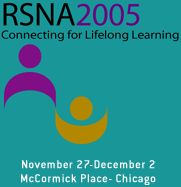
Abstract Archives of the RSNA, 2005
SSE22-02
Integration of a Physician Assistant (PA) into Patient Management on a Busy Non Vascular Interventional Radiology (IR) Department at an Academic Tertiary Care Hospital: Effect on Time Management and Patient Care
Scientific Papers
Presented on November 28, 2005
Presented as part of SSE22: Health Services, Policy, and Research (Practice Management)
Debra Ann Gervais MD, Presenter: Nothing to Disclose
Diane Alagno, Abstract Co-Author: Nothing to Disclose
Ronald Steven Arellano MD, Abstract Co-Author: Nothing to Disclose
Denise Palumbo, Abstract Co-Author: Nothing to Disclose
James Hunter Thrall MD, Abstract Co-Author: Nothing to Disclose
Peter Raff Mueller MD, Abstract Co-Author: Nothing to Disclose
To review our experience incorporating a PA into a busy nonvascular interventional radiology service.
Activity of a new PA in a newly created position was monitored for 4 months following hiring. The service had no prior experience with a PA, and patient management was previously entirely by radiologists who also performed 20–25 procedures daily. The PA focused on non-procedural aspects of the service. Data collected included inpatient/outpatient activity, communication with non-IR providers, and changes in patient management based on PA assessment.
The PA assumed primary responsibility for providing continuity of care on inpatient rounds and become the consistent IR liaison to other providers. The PA rounded on a median of 18 inpatients daily (Range 11-28). Additional inpatient visits initiated by consulting services occurred at a median rate of 5/day. Phone calls with other inpatient providers occurred at a median rate of 12.5/day (Range 3–29) and with outpatients at 3/day (1-8). Calls from both outpatients and non-IR providers increased as they became familiar with the PA. Changes in IR treatment plan that involved removing, repositioning, or adding catheters based on the PA’s assessment occurred at a median rate of 5/day. Availability of the PA often led to earlier execution of patient plans. For example, the PA removed inpatient catheters within 1–2 hours of the decision whereas radiologists functioning without the PA usually would remove catheters after the daily procedures were done, a delay of 2–6 hours. Additional functions included scheduling of imaging and discharge arrangements for outpatient catheter management. Introduction of the PA resulted in considerable time saved for radiologists to dedicate to other activities. Feedback from other providers was positive with most perceiving the service as more proactive after integration of the PA.
PA's are valuable on a busy IR team and can manage inpatient and outpatient issues. Advantages include allowing radiologists more time to focus on performance of procedures. Patient care is improved by providing a more timely performance of some IR patient management tasks.
D.A.G.: Consultant for ValleyLab
Gervais, D,
Alagno, D,
Arellano, R,
Palumbo, D,
Thrall, J,
Mueller, P,
Integration of a Physician Assistant (PA) into Patient Management on a Busy Non Vascular Interventional Radiology (IR) Department at an Academic Tertiary Care Hospital: Effect on Time Management and Patient Care. Radiological Society of North America 2005 Scientific Assembly and Annual Meeting, November 27 - December 2, 2005 ,Chicago IL.
http://archive.rsna.org/2005/4412468.html

